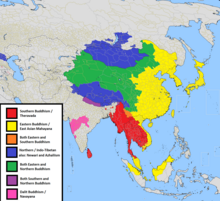东亚佛教
外观

东亚佛教泛称发展于东亚的佛教信仰,多属汉传大乘佛教教派,以汉译经典为本,依地域又分为中国佛教、日本佛教、越南佛教和朝鲜佛教[1][2]。东亚佛教在以上诸地均有重要的历史与文化地位,亦是现今较为流行的宗教之一。东亚佛教信仰亦在新加坡和大马等地的华人群体中流行。依照地理传统划分,东亚佛教是现今佛教的主要分支,信众占比逾半数[3][4]。
东亚佛教之信仰传统源于汉地,可追溯至汉朝,古典印度佛教经商路传入中原,受中华文化影响发生汉化[5]。东亚佛教内部,又产生如禅宗、净土宗、华严宗、天台宗、唐密宗等主要的宗派分支,分别对佛教经典产生独特解读[6]。
东亚佛教除沿袭印度佛教之基本教义外,亦包含一些东亚社会的传统习俗与观念,如汉地宗法信仰和儒家倡导之孝道观念,日本与韩国将佛教与当地的神道或朝鲜巫教融合信仰等等[7]。
东亚佛教大体遵循法藏部戒律[8],但也有例外,如日本一些宗派允许僧人结婚。这和明治维新期间当局废佛毁释,强迫部分宗派改变戒律的做法有关[9]。
参见
[编辑]参考资料
[编辑]- ^ The Buddhist World, The Buddhist World: Buddhism in East Asia - China, Japan, and Korea (页面存档备份,存于互联网档案馆).
- ^ Charles Orzech (2004), Esoteric Buddhism and the Tantras in East Asia. Brill Academic Publishers, pp. 3-4.
- ^ Pew Research Center, Global Religious Landscape: Buddhists (页面存档备份,存于互联网档案馆).
- ^ Johnson, Todd M.; Grim, Brian J. The World's Religions in Figures: An Introduction to International Religious Demography (PDF). Hoboken, NJ: Wiley-Blackwell. 2013: 34 [2 September 2013]. (原始内容 (PDF)存档于20 October 2013).
- ^ Gethin, Rupert, The Foundations of Buddhism, OUP Oxford, 1998, p. 257.
- ^ Williams, pAUL, Mahayana Buddhism: The Doctrinal Foundations, Taylor & Francis, 2008, P. 129.
- ^ Harvey, Peter, An Introduction to Buddhism, Second Edition: Teachings, History and Practices (Introduction to Religion) 2nd Edition, p. 212.
- ^ Gethin, Rupert, The Foundations of Buddhism, OUP Oxford, 1998, p. 260
- ^ Jaffe, Richard (1998). "Meiji Religious Policy, Soto Zen and the Clerical Marriage Problem". Japanese Journal of Religious Studies. 24 (1–2): 46. Archived from the original on November 19, 2014.

